Risk Assessment for Various Similar Construction Projects
VerifiedAdded on 2023/06/03
|14
|3423
|430
AI Summary
This report details the risks associated with undertaking road construction projects and what it would cost to undertake a major road construction project. The report includes an executive summary, risk assessment, estimate of costs, and a schedule to prepare a tender bid for a contract of this type with justification. The risks associated with the projects are under budgeting, political risks, failure to meet deadline, poor quality work, design changes midway, and financing challenges. The report also includes a risk matrix and mitigation measures for each risk. The estimated cost for the bid preparation is also included.
Contribute Materials
Your contribution can guide someone’s learning journey. Share your
documents today.

RISK ASSESSMENT FOR VARIOUS SIMILAR CONSTRUCTION PROJECTS1
Risk Assessment in Construction Projects
Name
Date
Risk Assessment in Construction Projects
Name
Date
Secure Best Marks with AI Grader
Need help grading? Try our AI Grader for instant feedback on your assignments.
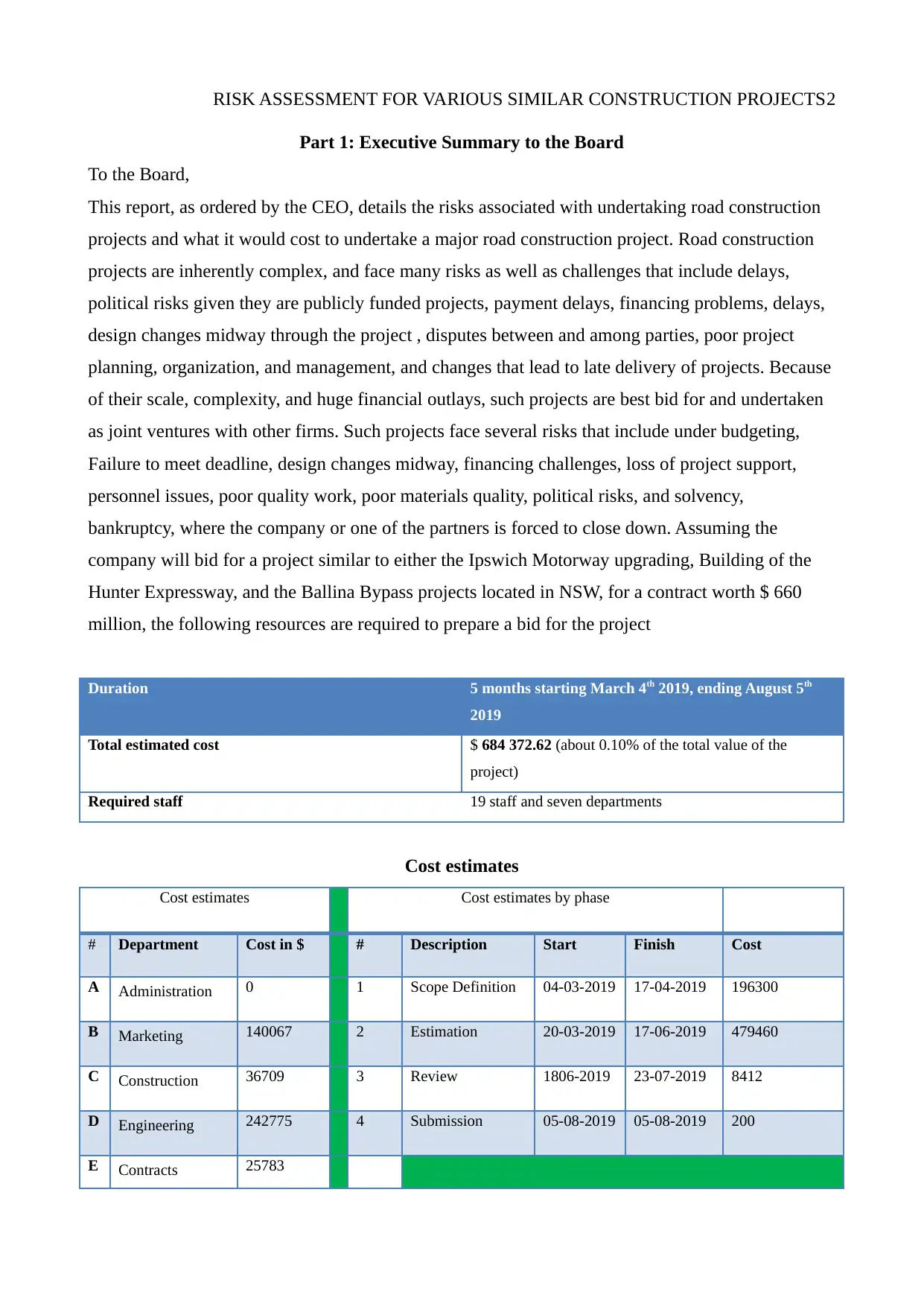
RISK ASSESSMENT FOR VARIOUS SIMILAR CONSTRUCTION PROJECTS2
Part 1: Executive Summary to the Board
To the Board,
This report, as ordered by the CEO, details the risks associated with undertaking road construction
projects and what it would cost to undertake a major road construction project. Road construction
projects are inherently complex, and face many risks as well as challenges that include delays,
political risks given they are publicly funded projects, payment delays, financing problems, delays,
design changes midway through the project , disputes between and among parties, poor project
planning, organization, and management, and changes that lead to late delivery of projects. Because
of their scale, complexity, and huge financial outlays, such projects are best bid for and undertaken
as joint ventures with other firms. Such projects face several risks that include under budgeting,
Failure to meet deadline, design changes midway, financing challenges, loss of project support,
personnel issues, poor quality work, poor materials quality, political risks, and solvency,
bankruptcy, where the company or one of the partners is forced to close down. Assuming the
company will bid for a project similar to either the Ipswich Motorway upgrading, Building of the
Hunter Expressway, and the Ballina Bypass projects located in NSW, for a contract worth $ 660
million, the following resources are required to prepare a bid for the project
Duration 5 months starting March 4th 2019, ending August 5th
2019
Total estimated cost $ 684 372.62 (about 0.10% of the total value of the
project)
Required staff 19 staff and seven departments
Cost estimates
Cost estimates Cost estimates by phase
# Department Cost in $ # Description Start Finish Cost
A Administration 0 1 Scope Definition 04-03-2019 17-04-2019 196300
B Marketing 140067 2 Estimation 20-03-2019 17-06-2019 479460
C Construction 36709 3 Review 1806-2019 23-07-2019 8412
D Engineering 242775 4 Submission 05-08-2019 05-08-2019 200
E Contracts 25783
Part 1: Executive Summary to the Board
To the Board,
This report, as ordered by the CEO, details the risks associated with undertaking road construction
projects and what it would cost to undertake a major road construction project. Road construction
projects are inherently complex, and face many risks as well as challenges that include delays,
political risks given they are publicly funded projects, payment delays, financing problems, delays,
design changes midway through the project , disputes between and among parties, poor project
planning, organization, and management, and changes that lead to late delivery of projects. Because
of their scale, complexity, and huge financial outlays, such projects are best bid for and undertaken
as joint ventures with other firms. Such projects face several risks that include under budgeting,
Failure to meet deadline, design changes midway, financing challenges, loss of project support,
personnel issues, poor quality work, poor materials quality, political risks, and solvency,
bankruptcy, where the company or one of the partners is forced to close down. Assuming the
company will bid for a project similar to either the Ipswich Motorway upgrading, Building of the
Hunter Expressway, and the Ballina Bypass projects located in NSW, for a contract worth $ 660
million, the following resources are required to prepare a bid for the project
Duration 5 months starting March 4th 2019, ending August 5th
2019
Total estimated cost $ 684 372.62 (about 0.10% of the total value of the
project)
Required staff 19 staff and seven departments
Cost estimates
Cost estimates Cost estimates by phase
# Department Cost in $ # Description Start Finish Cost
A Administration 0 1 Scope Definition 04-03-2019 17-04-2019 196300
B Marketing 140067 2 Estimation 20-03-2019 17-06-2019 479460
C Construction 36709 3 Review 1806-2019 23-07-2019 8412
D Engineering 242775 4 Submission 05-08-2019 05-08-2019 200
E Contracts 25783

RISK ASSESSMENT FOR VARIOUS SIMILAR CONSTRUCTION PROJECTS3
F Estimating 123287 Total estimated costs
G Planning 26487 Staff Costs 595106.63
Total Overheads 89265.99
Grand Total 684372.62
Percent of total project cost 0.1%
F Estimating 123287 Total estimated costs
G Planning 26487 Staff Costs 595106.63
Total Overheads 89265.99
Grand Total 684372.62
Percent of total project cost 0.1%
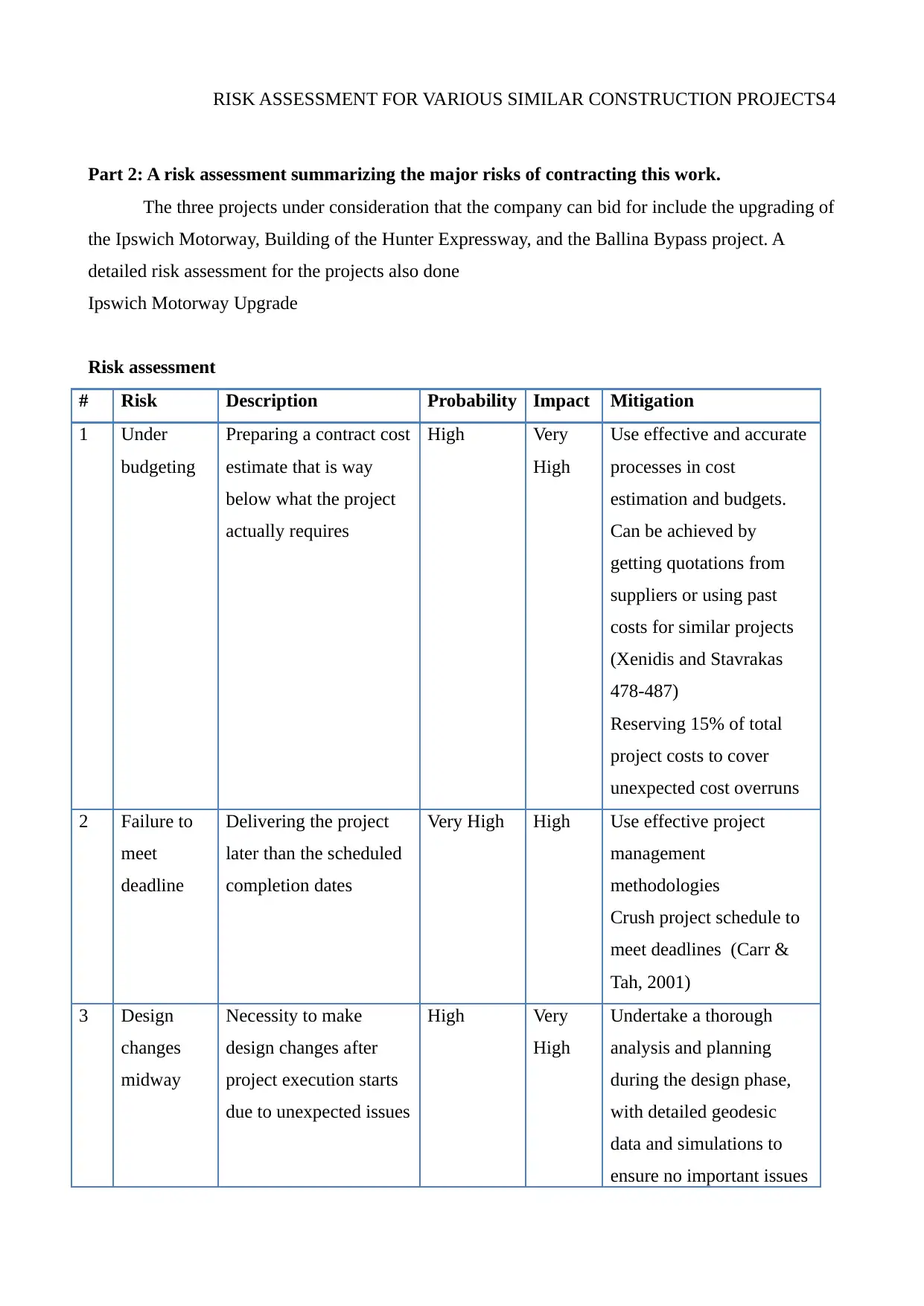
RISK ASSESSMENT FOR VARIOUS SIMILAR CONSTRUCTION PROJECTS4
Part 2: A risk assessment summarizing the major risks of contracting this work.
The three projects under consideration that the company can bid for include the upgrading of
the Ipswich Motorway, Building of the Hunter Expressway, and the Ballina Bypass project. A
detailed risk assessment for the projects also done
Ipswich Motorway Upgrade
Risk assessment
# Risk Description Probability Impact Mitigation
1 Under
budgeting
Preparing a contract cost
estimate that is way
below what the project
actually requires
High Very
High
Use effective and accurate
processes in cost
estimation and budgets.
Can be achieved by
getting quotations from
suppliers or using past
costs for similar projects
(Xenidis and Stavrakas
478-487)
Reserving 15% of total
project costs to cover
unexpected cost overruns
2 Failure to
meet
deadline
Delivering the project
later than the scheduled
completion dates
Very High High Use effective project
management
methodologies
Crush project schedule to
meet deadlines (Carr &
Tah, 2001)
3 Design
changes
midway
Necessity to make
design changes after
project execution starts
due to unexpected issues
High Very
High
Undertake a thorough
analysis and planning
during the design phase,
with detailed geodesic
data and simulations to
ensure no important issues
Part 2: A risk assessment summarizing the major risks of contracting this work.
The three projects under consideration that the company can bid for include the upgrading of
the Ipswich Motorway, Building of the Hunter Expressway, and the Ballina Bypass project. A
detailed risk assessment for the projects also done
Ipswich Motorway Upgrade
Risk assessment
# Risk Description Probability Impact Mitigation
1 Under
budgeting
Preparing a contract cost
estimate that is way
below what the project
actually requires
High Very
High
Use effective and accurate
processes in cost
estimation and budgets.
Can be achieved by
getting quotations from
suppliers or using past
costs for similar projects
(Xenidis and Stavrakas
478-487)
Reserving 15% of total
project costs to cover
unexpected cost overruns
2 Failure to
meet
deadline
Delivering the project
later than the scheduled
completion dates
Very High High Use effective project
management
methodologies
Crush project schedule to
meet deadlines (Carr &
Tah, 2001)
3 Design
changes
midway
Necessity to make
design changes after
project execution starts
due to unexpected issues
High Very
High
Undertake a thorough
analysis and planning
during the design phase,
with detailed geodesic
data and simulations to
ensure no important issues
Secure Best Marks with AI Grader
Need help grading? Try our AI Grader for instant feedback on your assignments.
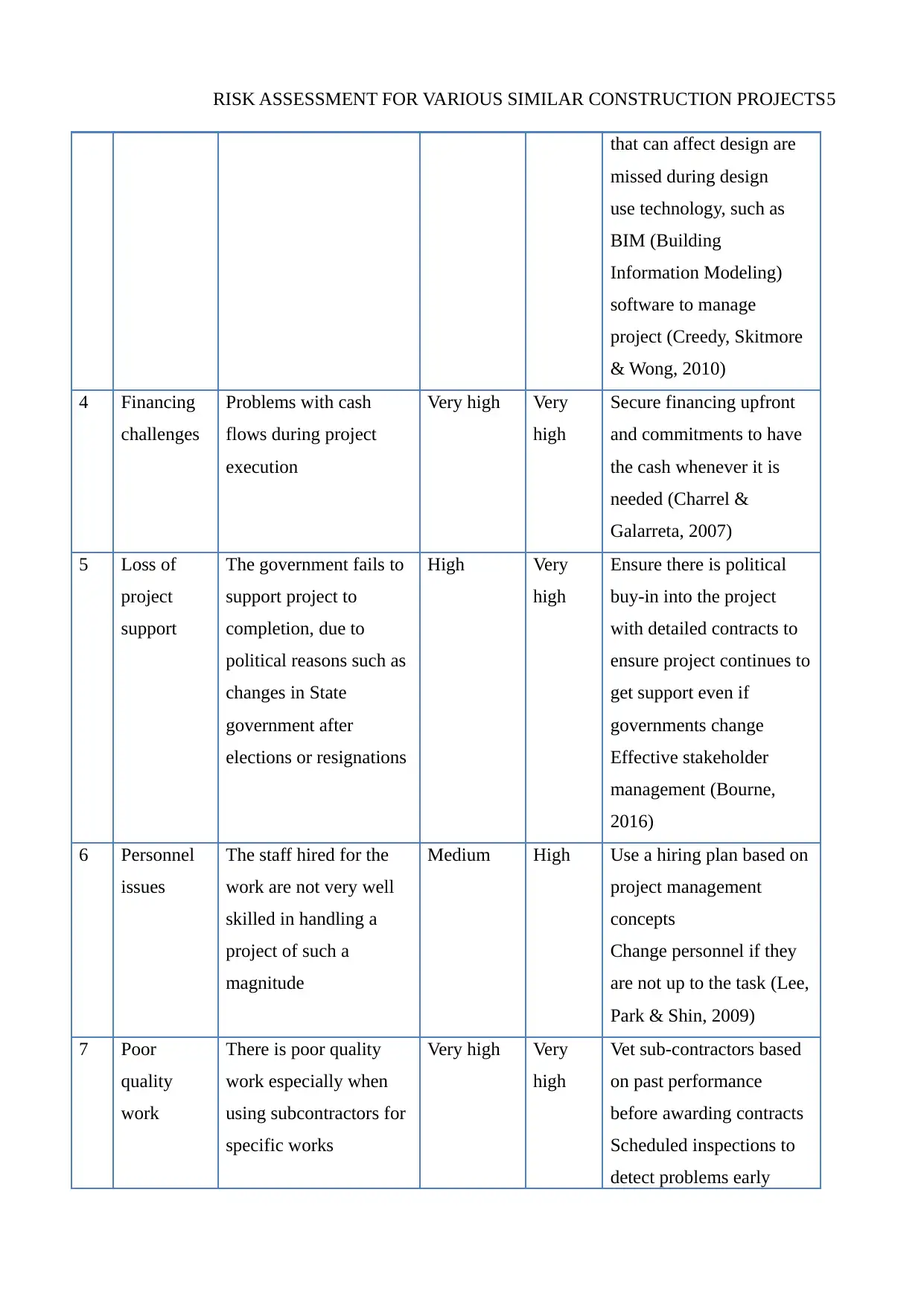
RISK ASSESSMENT FOR VARIOUS SIMILAR CONSTRUCTION PROJECTS5
that can affect design are
missed during design
use technology, such as
BIM (Building
Information Modeling)
software to manage
project (Creedy, Skitmore
& Wong, 2010)
4 Financing
challenges
Problems with cash
flows during project
execution
Very high Very
high
Secure financing upfront
and commitments to have
the cash whenever it is
needed (Charrel &
Galarreta, 2007)
5 Loss of
project
support
The government fails to
support project to
completion, due to
political reasons such as
changes in State
government after
elections or resignations
High Very
high
Ensure there is political
buy-in into the project
with detailed contracts to
ensure project continues to
get support even if
governments change
Effective stakeholder
management (Bourne,
2016)
6 Personnel
issues
The staff hired for the
work are not very well
skilled in handling a
project of such a
magnitude
Medium High Use a hiring plan based on
project management
concepts
Change personnel if they
are not up to the task (Lee,
Park & Shin, 2009)
7 Poor
quality
work
There is poor quality
work especially when
using subcontractors for
specific works
Very high Very
high
Vet sub-contractors based
on past performance
before awarding contracts
Scheduled inspections to
detect problems early
that can affect design are
missed during design
use technology, such as
BIM (Building
Information Modeling)
software to manage
project (Creedy, Skitmore
& Wong, 2010)
4 Financing
challenges
Problems with cash
flows during project
execution
Very high Very
high
Secure financing upfront
and commitments to have
the cash whenever it is
needed (Charrel &
Galarreta, 2007)
5 Loss of
project
support
The government fails to
support project to
completion, due to
political reasons such as
changes in State
government after
elections or resignations
High Very
high
Ensure there is political
buy-in into the project
with detailed contracts to
ensure project continues to
get support even if
governments change
Effective stakeholder
management (Bourne,
2016)
6 Personnel
issues
The staff hired for the
work are not very well
skilled in handling a
project of such a
magnitude
Medium High Use a hiring plan based on
project management
concepts
Change personnel if they
are not up to the task (Lee,
Park & Shin, 2009)
7 Poor
quality
work
There is poor quality
work especially when
using subcontractors for
specific works
Very high Very
high
Vet sub-contractors based
on past performance
before awarding contracts
Scheduled inspections to
detect problems early
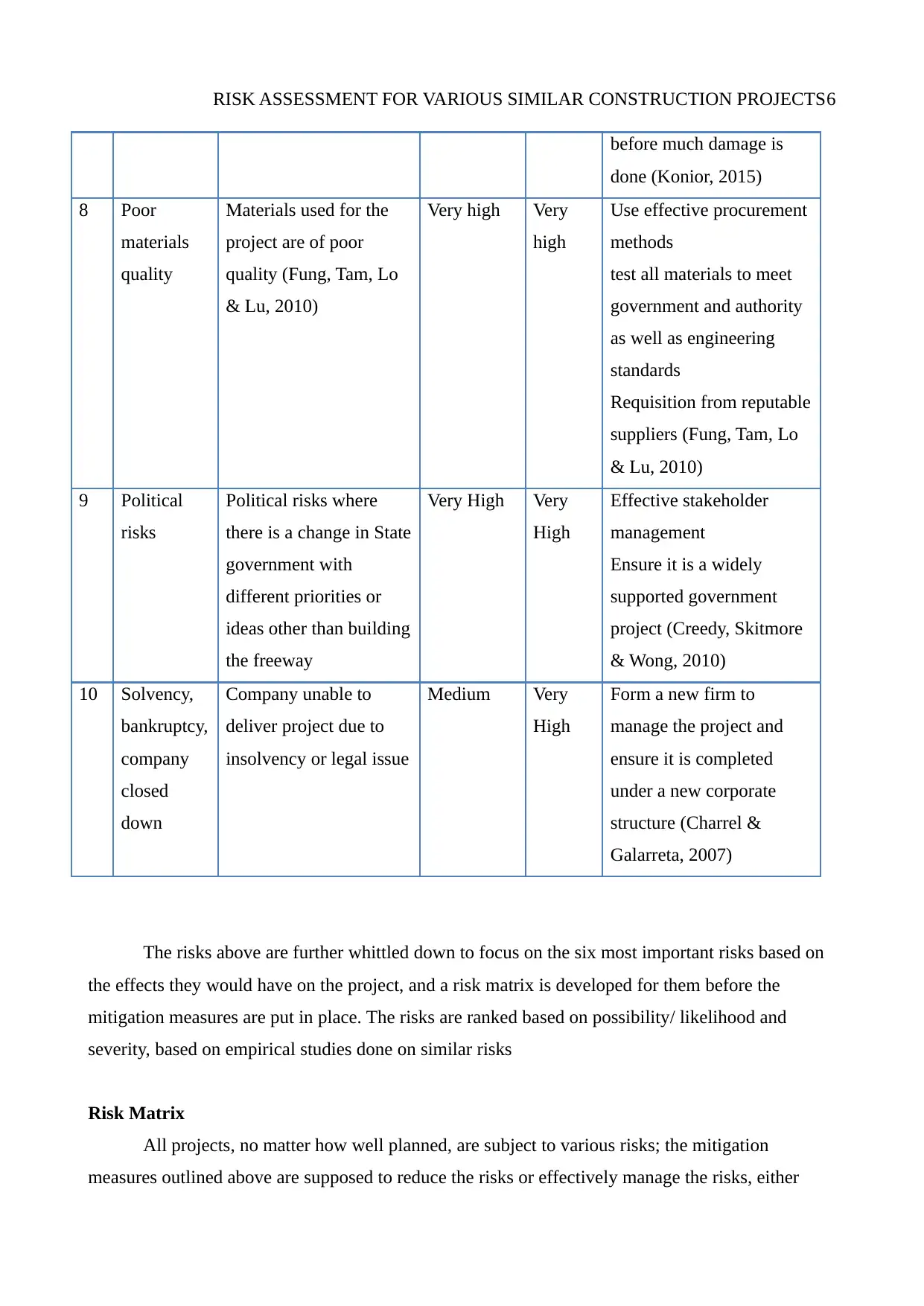
RISK ASSESSMENT FOR VARIOUS SIMILAR CONSTRUCTION PROJECTS6
before much damage is
done (Konior, 2015)
8 Poor
materials
quality
Materials used for the
project are of poor
quality (Fung, Tam, Lo
& Lu, 2010)
Very high Very
high
Use effective procurement
methods
test all materials to meet
government and authority
as well as engineering
standards
Requisition from reputable
suppliers (Fung, Tam, Lo
& Lu, 2010)
9 Political
risks
Political risks where
there is a change in State
government with
different priorities or
ideas other than building
the freeway
Very High Very
High
Effective stakeholder
management
Ensure it is a widely
supported government
project (Creedy, Skitmore
& Wong, 2010)
10 Solvency,
bankruptcy,
company
closed
down
Company unable to
deliver project due to
insolvency or legal issue
Medium Very
High
Form a new firm to
manage the project and
ensure it is completed
under a new corporate
structure (Charrel &
Galarreta, 2007)
The risks above are further whittled down to focus on the six most important risks based on
the effects they would have on the project, and a risk matrix is developed for them before the
mitigation measures are put in place. The risks are ranked based on possibility/ likelihood and
severity, based on empirical studies done on similar risks
Risk Matrix
All projects, no matter how well planned, are subject to various risks; the mitigation
measures outlined above are supposed to reduce the risks or effectively manage the risks, either
before much damage is
done (Konior, 2015)
8 Poor
materials
quality
Materials used for the
project are of poor
quality (Fung, Tam, Lo
& Lu, 2010)
Very high Very
high
Use effective procurement
methods
test all materials to meet
government and authority
as well as engineering
standards
Requisition from reputable
suppliers (Fung, Tam, Lo
& Lu, 2010)
9 Political
risks
Political risks where
there is a change in State
government with
different priorities or
ideas other than building
the freeway
Very High Very
High
Effective stakeholder
management
Ensure it is a widely
supported government
project (Creedy, Skitmore
& Wong, 2010)
10 Solvency,
bankruptcy,
company
closed
down
Company unable to
deliver project due to
insolvency or legal issue
Medium Very
High
Form a new firm to
manage the project and
ensure it is completed
under a new corporate
structure (Charrel &
Galarreta, 2007)
The risks above are further whittled down to focus on the six most important risks based on
the effects they would have on the project, and a risk matrix is developed for them before the
mitigation measures are put in place. The risks are ranked based on possibility/ likelihood and
severity, based on empirical studies done on similar risks
Risk Matrix
All projects, no matter how well planned, are subject to various risks; the mitigation
measures outlined above are supposed to reduce the risks or effectively manage the risks, either
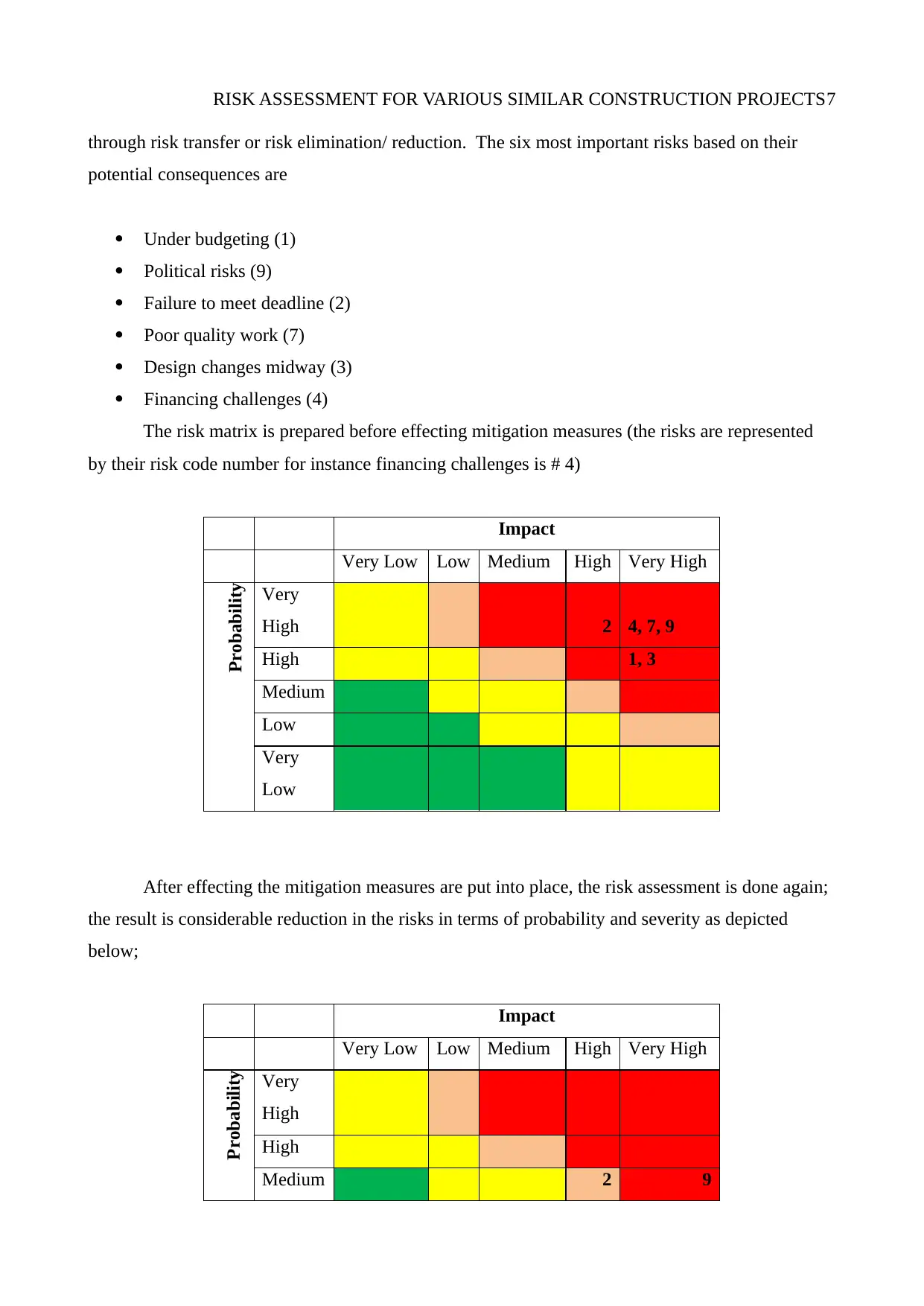
RISK ASSESSMENT FOR VARIOUS SIMILAR CONSTRUCTION PROJECTS7
through risk transfer or risk elimination/ reduction. The six most important risks based on their
potential consequences are
Under budgeting (1)
Political risks (9)
Failure to meet deadline (2)
Poor quality work (7)
Design changes midway (3)
Financing challenges (4)
The risk matrix is prepared before effecting mitigation measures (the risks are represented
by their risk code number for instance financing challenges is # 4)
Impact
Very Low Low Medium High Very High
Probability Very
High 2 4, 7, 9
High 1, 3
Medium
Low
Very
Low
After effecting the mitigation measures are put into place, the risk assessment is done again;
the result is considerable reduction in the risks in terms of probability and severity as depicted
below;
Impact
Very Low Low Medium High Very High
Probability Very
High
High
Medium 2 9
through risk transfer or risk elimination/ reduction. The six most important risks based on their
potential consequences are
Under budgeting (1)
Political risks (9)
Failure to meet deadline (2)
Poor quality work (7)
Design changes midway (3)
Financing challenges (4)
The risk matrix is prepared before effecting mitigation measures (the risks are represented
by their risk code number for instance financing challenges is # 4)
Impact
Very Low Low Medium High Very High
Probability Very
High 2 4, 7, 9
High 1, 3
Medium
Low
Very
Low
After effecting the mitigation measures are put into place, the risk assessment is done again;
the result is considerable reduction in the risks in terms of probability and severity as depicted
below;
Impact
Very Low Low Medium High Very High
Probability Very
High
High
Medium 2 9
Paraphrase This Document
Need a fresh take? Get an instant paraphrase of this document with our AI Paraphraser
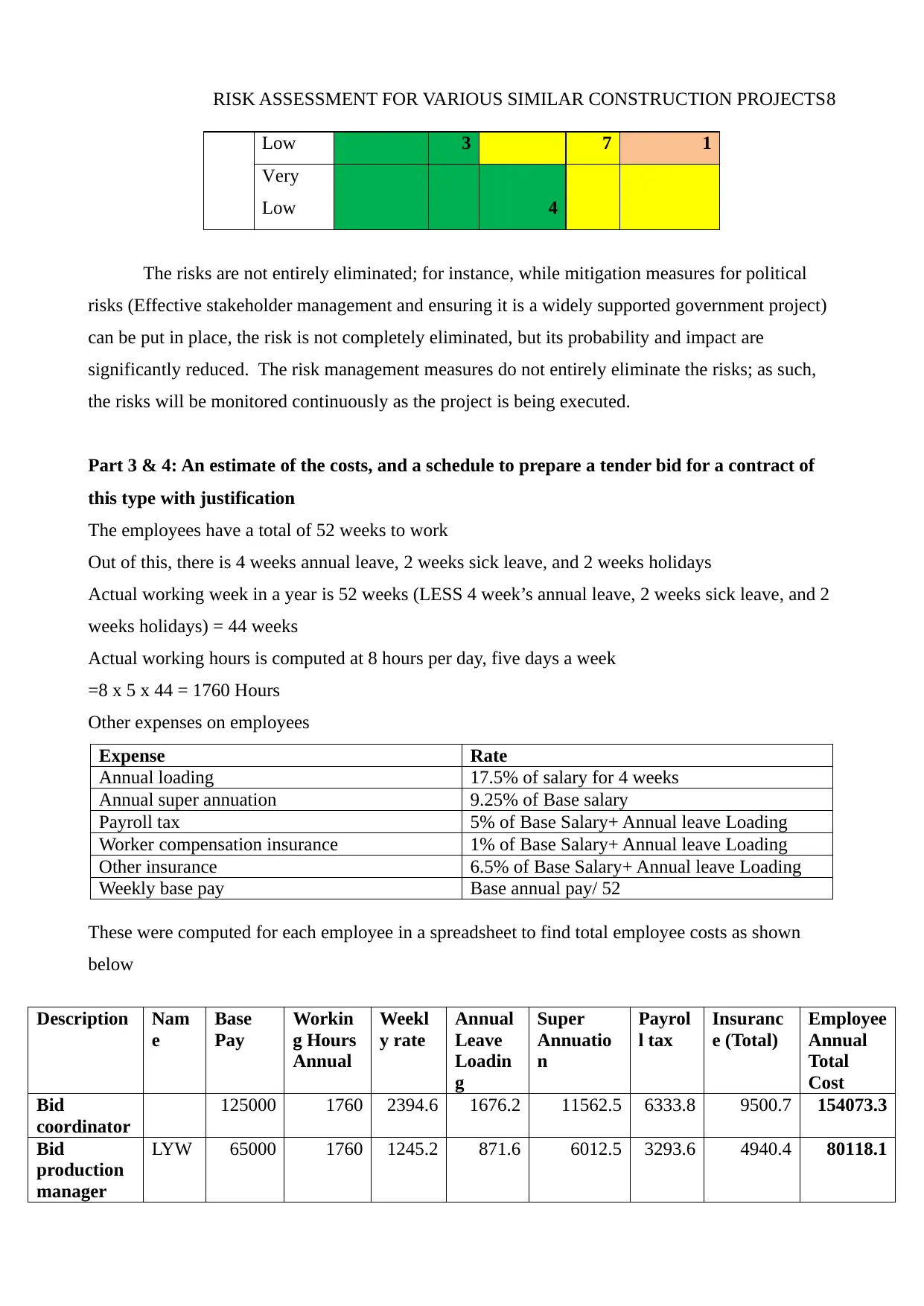
RISK ASSESSMENT FOR VARIOUS SIMILAR CONSTRUCTION PROJECTS8
Low 3 7 1
Very
Low 4
The risks are not entirely eliminated; for instance, while mitigation measures for political
risks (Effective stakeholder management and ensuring it is a widely supported government project)
can be put in place, the risk is not completely eliminated, but its probability and impact are
significantly reduced. The risk management measures do not entirely eliminate the risks; as such,
the risks will be monitored continuously as the project is being executed.
Part 3 & 4: An estimate of the costs, and a schedule to prepare a tender bid for a contract of
this type with justification
The employees have a total of 52 weeks to work
Out of this, there is 4 weeks annual leave, 2 weeks sick leave, and 2 weeks holidays
Actual working week in a year is 52 weeks (LESS 4 week’s annual leave, 2 weeks sick leave, and 2
weeks holidays) = 44 weeks
Actual working hours is computed at 8 hours per day, five days a week
=8 x 5 x 44 = 1760 Hours
Other expenses on employees
Expense Rate
Annual loading 17.5% of salary for 4 weeks
Annual super annuation 9.25% of Base salary
Payroll tax 5% of Base Salary+ Annual leave Loading
Worker compensation insurance 1% of Base Salary+ Annual leave Loading
Other insurance 6.5% of Base Salary+ Annual leave Loading
Weekly base pay Base annual pay/ 52
These were computed for each employee in a spreadsheet to find total employee costs as shown
below
Description Nam
e
Base
Pay
Workin
g Hours
Annual
Weekl
y rate
Annual
Leave
Loadin
g
Super
Annuatio
n
Payrol
l tax
Insuranc
e (Total)
Employee
Annual
Total
Cost
Bid
coordinator
125000 1760 2394.6 1676.2 11562.5 6333.8 9500.7 154073.3
Bid
production
manager
LYW 65000 1760 1245.2 871.6 6012.5 3293.6 4940.4 80118.1
Low 3 7 1
Very
Low 4
The risks are not entirely eliminated; for instance, while mitigation measures for political
risks (Effective stakeholder management and ensuring it is a widely supported government project)
can be put in place, the risk is not completely eliminated, but its probability and impact are
significantly reduced. The risk management measures do not entirely eliminate the risks; as such,
the risks will be monitored continuously as the project is being executed.
Part 3 & 4: An estimate of the costs, and a schedule to prepare a tender bid for a contract of
this type with justification
The employees have a total of 52 weeks to work
Out of this, there is 4 weeks annual leave, 2 weeks sick leave, and 2 weeks holidays
Actual working week in a year is 52 weeks (LESS 4 week’s annual leave, 2 weeks sick leave, and 2
weeks holidays) = 44 weeks
Actual working hours is computed at 8 hours per day, five days a week
=8 x 5 x 44 = 1760 Hours
Other expenses on employees
Expense Rate
Annual loading 17.5% of salary for 4 weeks
Annual super annuation 9.25% of Base salary
Payroll tax 5% of Base Salary+ Annual leave Loading
Worker compensation insurance 1% of Base Salary+ Annual leave Loading
Other insurance 6.5% of Base Salary+ Annual leave Loading
Weekly base pay Base annual pay/ 52
These were computed for each employee in a spreadsheet to find total employee costs as shown
below
Description Nam
e
Base
Pay
Workin
g Hours
Annual
Weekl
y rate
Annual
Leave
Loadin
g
Super
Annuatio
n
Payrol
l tax
Insuranc
e (Total)
Employee
Annual
Total
Cost
Bid
coordinator
125000 1760 2394.6 1676.2 11562.5 6333.8 9500.7 154073.3
Bid
production
manager
LYW 65000 1760 1245.2 871.6 6012.5 3293.6 4940.4 80118.1
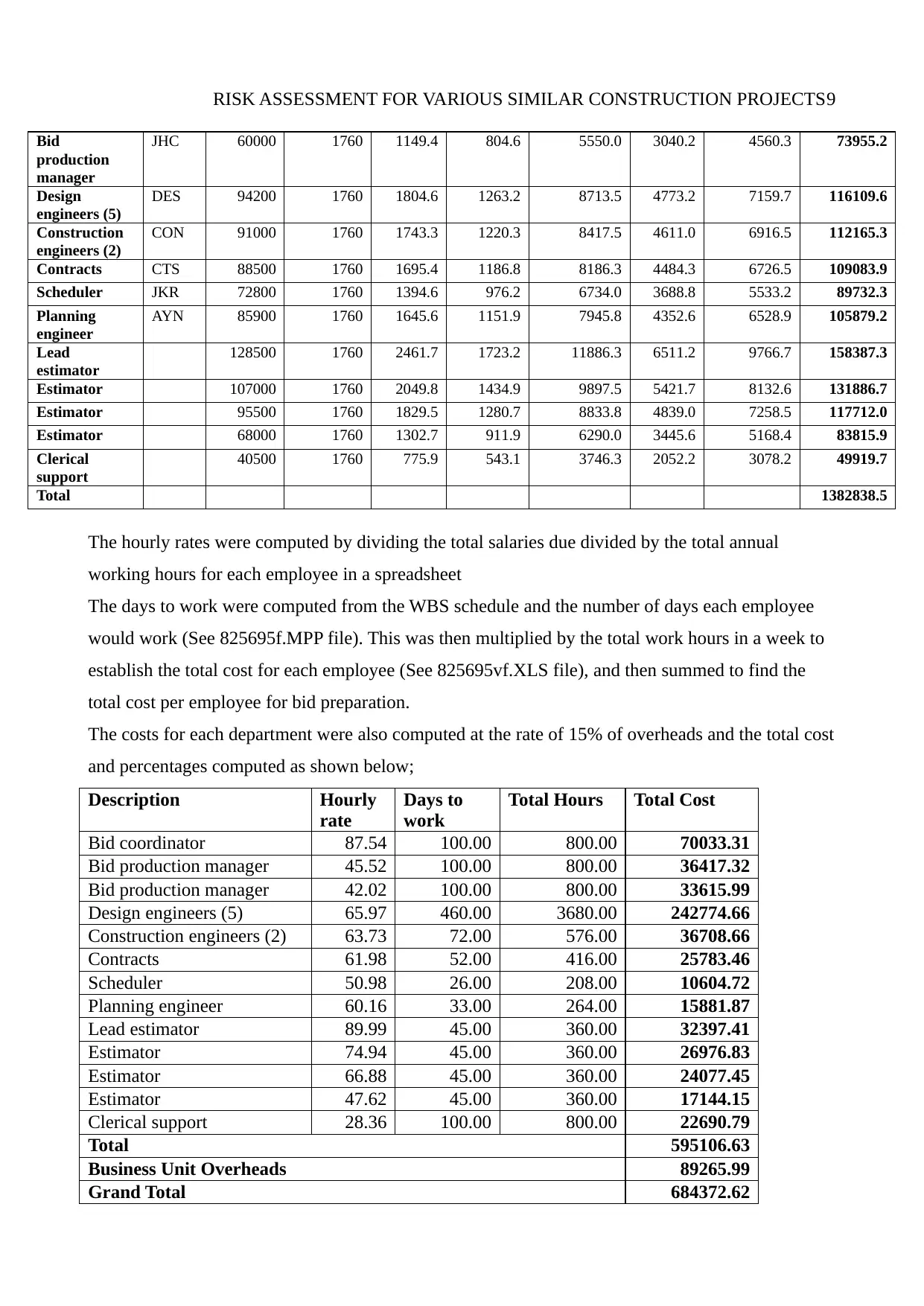
RISK ASSESSMENT FOR VARIOUS SIMILAR CONSTRUCTION PROJECTS9
Bid
production
manager
JHC 60000 1760 1149.4 804.6 5550.0 3040.2 4560.3 73955.2
Design
engineers (5)
DES 94200 1760 1804.6 1263.2 8713.5 4773.2 7159.7 116109.6
Construction
engineers (2)
CON 91000 1760 1743.3 1220.3 8417.5 4611.0 6916.5 112165.3
Contracts CTS 88500 1760 1695.4 1186.8 8186.3 4484.3 6726.5 109083.9
Scheduler JKR 72800 1760 1394.6 976.2 6734.0 3688.8 5533.2 89732.3
Planning
engineer
AYN 85900 1760 1645.6 1151.9 7945.8 4352.6 6528.9 105879.2
Lead
estimator
128500 1760 2461.7 1723.2 11886.3 6511.2 9766.7 158387.3
Estimator 107000 1760 2049.8 1434.9 9897.5 5421.7 8132.6 131886.7
Estimator 95500 1760 1829.5 1280.7 8833.8 4839.0 7258.5 117712.0
Estimator 68000 1760 1302.7 911.9 6290.0 3445.6 5168.4 83815.9
Clerical
support
40500 1760 775.9 543.1 3746.3 2052.2 3078.2 49919.7
Total 1382838.5
The hourly rates were computed by dividing the total salaries due divided by the total annual
working hours for each employee in a spreadsheet
The days to work were computed from the WBS schedule and the number of days each employee
would work (See 825695f.MPP file). This was then multiplied by the total work hours in a week to
establish the total cost for each employee (See 825695vf.XLS file), and then summed to find the
total cost per employee for bid preparation.
The costs for each department were also computed at the rate of 15% of overheads and the total cost
and percentages computed as shown below;
Description Hourly
rate
Days to
work
Total Hours Total Cost
Bid coordinator 87.54 100.00 800.00 70033.31
Bid production manager 45.52 100.00 800.00 36417.32
Bid production manager 42.02 100.00 800.00 33615.99
Design engineers (5) 65.97 460.00 3680.00 242774.66
Construction engineers (2) 63.73 72.00 576.00 36708.66
Contracts 61.98 52.00 416.00 25783.46
Scheduler 50.98 26.00 208.00 10604.72
Planning engineer 60.16 33.00 264.00 15881.87
Lead estimator 89.99 45.00 360.00 32397.41
Estimator 74.94 45.00 360.00 26976.83
Estimator 66.88 45.00 360.00 24077.45
Estimator 47.62 45.00 360.00 17144.15
Clerical support 28.36 100.00 800.00 22690.79
Total 595106.63
Business Unit Overheads 89265.99
Grand Total 684372.62
Bid
production
manager
JHC 60000 1760 1149.4 804.6 5550.0 3040.2 4560.3 73955.2
Design
engineers (5)
DES 94200 1760 1804.6 1263.2 8713.5 4773.2 7159.7 116109.6
Construction
engineers (2)
CON 91000 1760 1743.3 1220.3 8417.5 4611.0 6916.5 112165.3
Contracts CTS 88500 1760 1695.4 1186.8 8186.3 4484.3 6726.5 109083.9
Scheduler JKR 72800 1760 1394.6 976.2 6734.0 3688.8 5533.2 89732.3
Planning
engineer
AYN 85900 1760 1645.6 1151.9 7945.8 4352.6 6528.9 105879.2
Lead
estimator
128500 1760 2461.7 1723.2 11886.3 6511.2 9766.7 158387.3
Estimator 107000 1760 2049.8 1434.9 9897.5 5421.7 8132.6 131886.7
Estimator 95500 1760 1829.5 1280.7 8833.8 4839.0 7258.5 117712.0
Estimator 68000 1760 1302.7 911.9 6290.0 3445.6 5168.4 83815.9
Clerical
support
40500 1760 775.9 543.1 3746.3 2052.2 3078.2 49919.7
Total 1382838.5
The hourly rates were computed by dividing the total salaries due divided by the total annual
working hours for each employee in a spreadsheet
The days to work were computed from the WBS schedule and the number of days each employee
would work (See 825695f.MPP file). This was then multiplied by the total work hours in a week to
establish the total cost for each employee (See 825695vf.XLS file), and then summed to find the
total cost per employee for bid preparation.
The costs for each department were also computed at the rate of 15% of overheads and the total cost
and percentages computed as shown below;
Description Hourly
rate
Days to
work
Total Hours Total Cost
Bid coordinator 87.54 100.00 800.00 70033.31
Bid production manager 45.52 100.00 800.00 36417.32
Bid production manager 42.02 100.00 800.00 33615.99
Design engineers (5) 65.97 460.00 3680.00 242774.66
Construction engineers (2) 63.73 72.00 576.00 36708.66
Contracts 61.98 52.00 416.00 25783.46
Scheduler 50.98 26.00 208.00 10604.72
Planning engineer 60.16 33.00 264.00 15881.87
Lead estimator 89.99 45.00 360.00 32397.41
Estimator 74.94 45.00 360.00 26976.83
Estimator 66.88 45.00 360.00 24077.45
Estimator 47.62 45.00 360.00 17144.15
Clerical support 28.36 100.00 800.00 22690.79
Total 595106.63
Business Unit Overheads 89265.99
Grand Total 684372.62
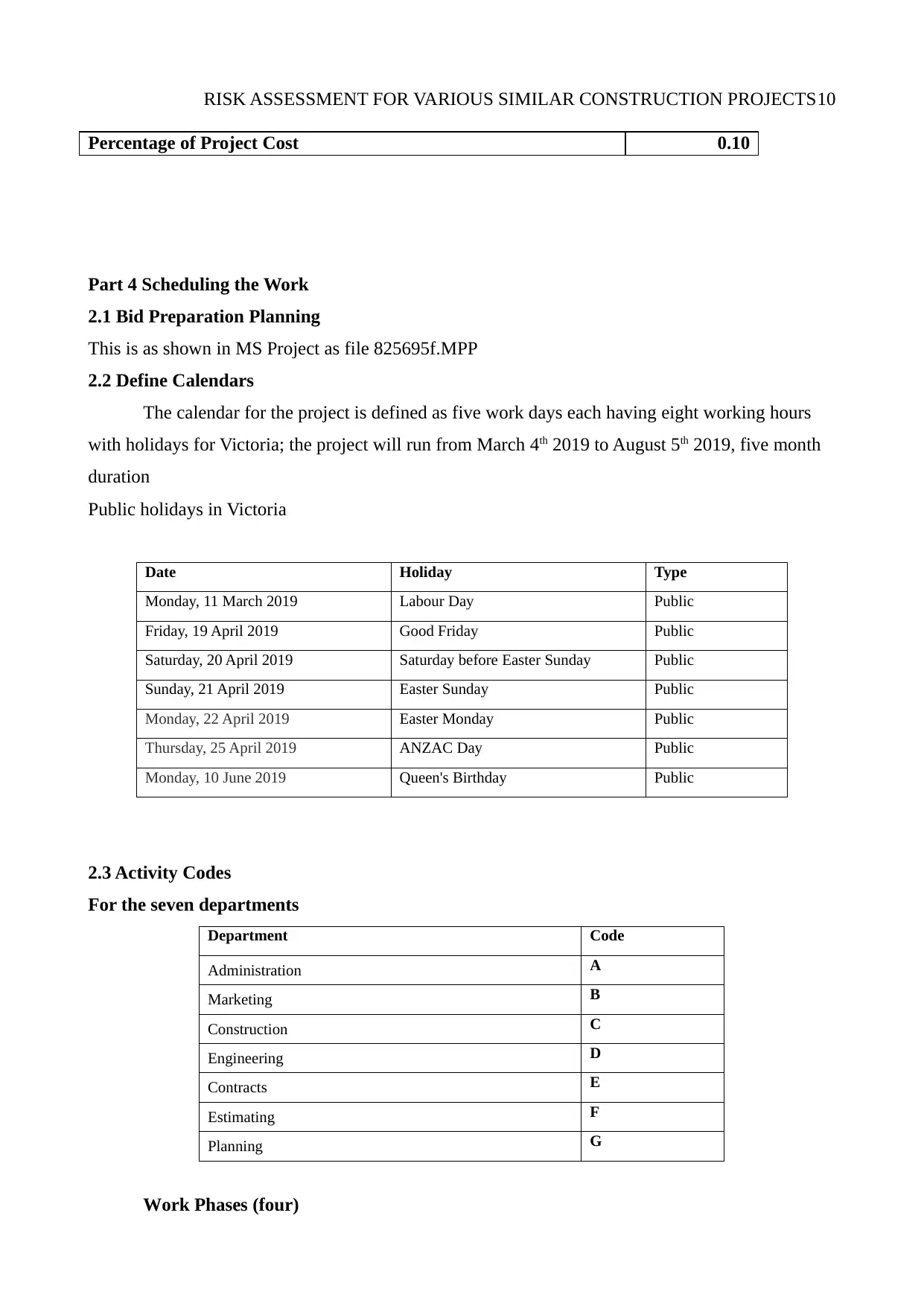
RISK ASSESSMENT FOR VARIOUS SIMILAR CONSTRUCTION PROJECTS10
Percentage of Project Cost 0.10
Part 4 Scheduling the Work
2.1 Bid Preparation Planning
This is as shown in MS Project as file 825695f.MPP
2.2 Define Calendars
The calendar for the project is defined as five work days each having eight working hours
with holidays for Victoria; the project will run from March 4th 2019 to August 5th 2019, five month
duration
Public holidays in Victoria
Date Holiday Type
Monday, 11 March 2019 Labour Day Public
Friday, 19 April 2019 Good Friday Public
Saturday, 20 April 2019 Saturday before Easter Sunday Public
Sunday, 21 April 2019 Easter Sunday Public
Monday, 22 April 2019 Easter Monday Public
Thursday, 25 April 2019 ANZAC Day Public
Monday, 10 June 2019 Queen's Birthday Public
2.3 Activity Codes
For the seven departments
Department Code
Administration A
Marketing B
Construction C
Engineering D
Contracts E
Estimating F
Planning G
Work Phases (four)
Percentage of Project Cost 0.10
Part 4 Scheduling the Work
2.1 Bid Preparation Planning
This is as shown in MS Project as file 825695f.MPP
2.2 Define Calendars
The calendar for the project is defined as five work days each having eight working hours
with holidays for Victoria; the project will run from March 4th 2019 to August 5th 2019, five month
duration
Public holidays in Victoria
Date Holiday Type
Monday, 11 March 2019 Labour Day Public
Friday, 19 April 2019 Good Friday Public
Saturday, 20 April 2019 Saturday before Easter Sunday Public
Sunday, 21 April 2019 Easter Sunday Public
Monday, 22 April 2019 Easter Monday Public
Thursday, 25 April 2019 ANZAC Day Public
Monday, 10 June 2019 Queen's Birthday Public
2.3 Activity Codes
For the seven departments
Department Code
Administration A
Marketing B
Construction C
Engineering D
Contracts E
Estimating F
Planning G
Work Phases (four)
Secure Best Marks with AI Grader
Need help grading? Try our AI Grader for instant feedback on your assignments.
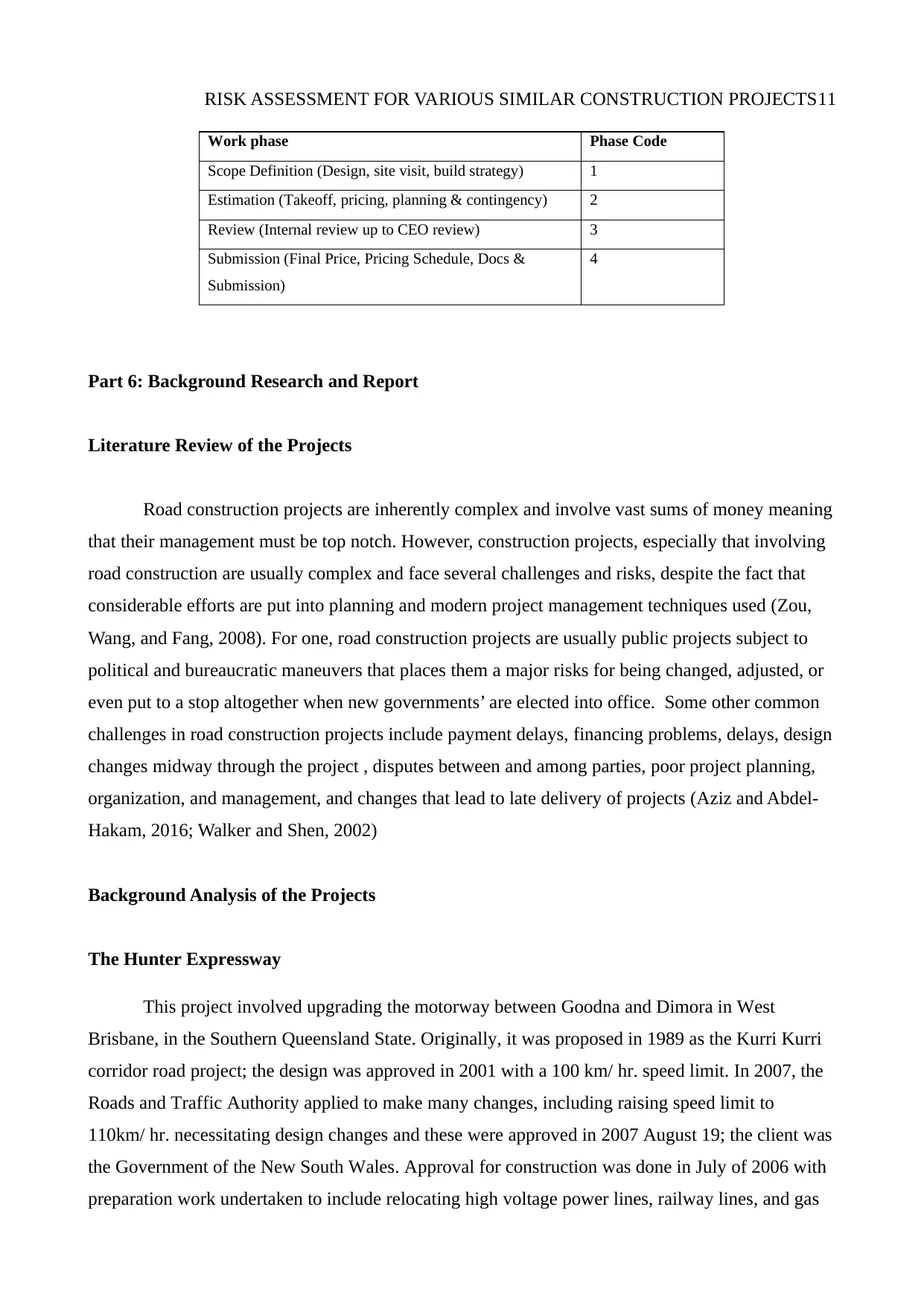
RISK ASSESSMENT FOR VARIOUS SIMILAR CONSTRUCTION PROJECTS11
Work phase Phase Code
Scope Definition (Design, site visit, build strategy) 1
Estimation (Takeoff, pricing, planning & contingency) 2
Review (Internal review up to CEO review) 3
Submission (Final Price, Pricing Schedule, Docs &
Submission)
4
Part 6: Background Research and Report
Literature Review of the Projects
Road construction projects are inherently complex and involve vast sums of money meaning
that their management must be top notch. However, construction projects, especially that involving
road construction are usually complex and face several challenges and risks, despite the fact that
considerable efforts are put into planning and modern project management techniques used (Zou,
Wang, and Fang, 2008). For one, road construction projects are usually public projects subject to
political and bureaucratic maneuvers that places them a major risks for being changed, adjusted, or
even put to a stop altogether when new governments’ are elected into office. Some other common
challenges in road construction projects include payment delays, financing problems, delays, design
changes midway through the project , disputes between and among parties, poor project planning,
organization, and management, and changes that lead to late delivery of projects (Aziz and Abdel-
Hakam, 2016; Walker and Shen, 2002)
Background Analysis of the Projects
The Hunter Expressway
This project involved upgrading the motorway between Goodna and Dimora in West
Brisbane, in the Southern Queensland State. Originally, it was proposed in 1989 as the Kurri Kurri
corridor road project; the design was approved in 2001 with a 100 km/ hr. speed limit. In 2007, the
Roads and Traffic Authority applied to make many changes, including raising speed limit to
110km/ hr. necessitating design changes and these were approved in 2007 August 19; the client was
the Government of the New South Wales. Approval for construction was done in July of 2006 with
preparation work undertaken to include relocating high voltage power lines, railway lines, and gas
Work phase Phase Code
Scope Definition (Design, site visit, build strategy) 1
Estimation (Takeoff, pricing, planning & contingency) 2
Review (Internal review up to CEO review) 3
Submission (Final Price, Pricing Schedule, Docs &
Submission)
4
Part 6: Background Research and Report
Literature Review of the Projects
Road construction projects are inherently complex and involve vast sums of money meaning
that their management must be top notch. However, construction projects, especially that involving
road construction are usually complex and face several challenges and risks, despite the fact that
considerable efforts are put into planning and modern project management techniques used (Zou,
Wang, and Fang, 2008). For one, road construction projects are usually public projects subject to
political and bureaucratic maneuvers that places them a major risks for being changed, adjusted, or
even put to a stop altogether when new governments’ are elected into office. Some other common
challenges in road construction projects include payment delays, financing problems, delays, design
changes midway through the project , disputes between and among parties, poor project planning,
organization, and management, and changes that lead to late delivery of projects (Aziz and Abdel-
Hakam, 2016; Walker and Shen, 2002)
Background Analysis of the Projects
The Hunter Expressway
This project involved upgrading the motorway between Goodna and Dimora in West
Brisbane, in the Southern Queensland State. Originally, it was proposed in 1989 as the Kurri Kurri
corridor road project; the design was approved in 2001 with a 100 km/ hr. speed limit. In 2007, the
Roads and Traffic Authority applied to make many changes, including raising speed limit to
110km/ hr. necessitating design changes and these were approved in 2007 August 19; the client was
the Government of the New South Wales. Approval for construction was done in July of 2006 with
preparation work undertaken to include relocating high voltage power lines, railway lines, and gas
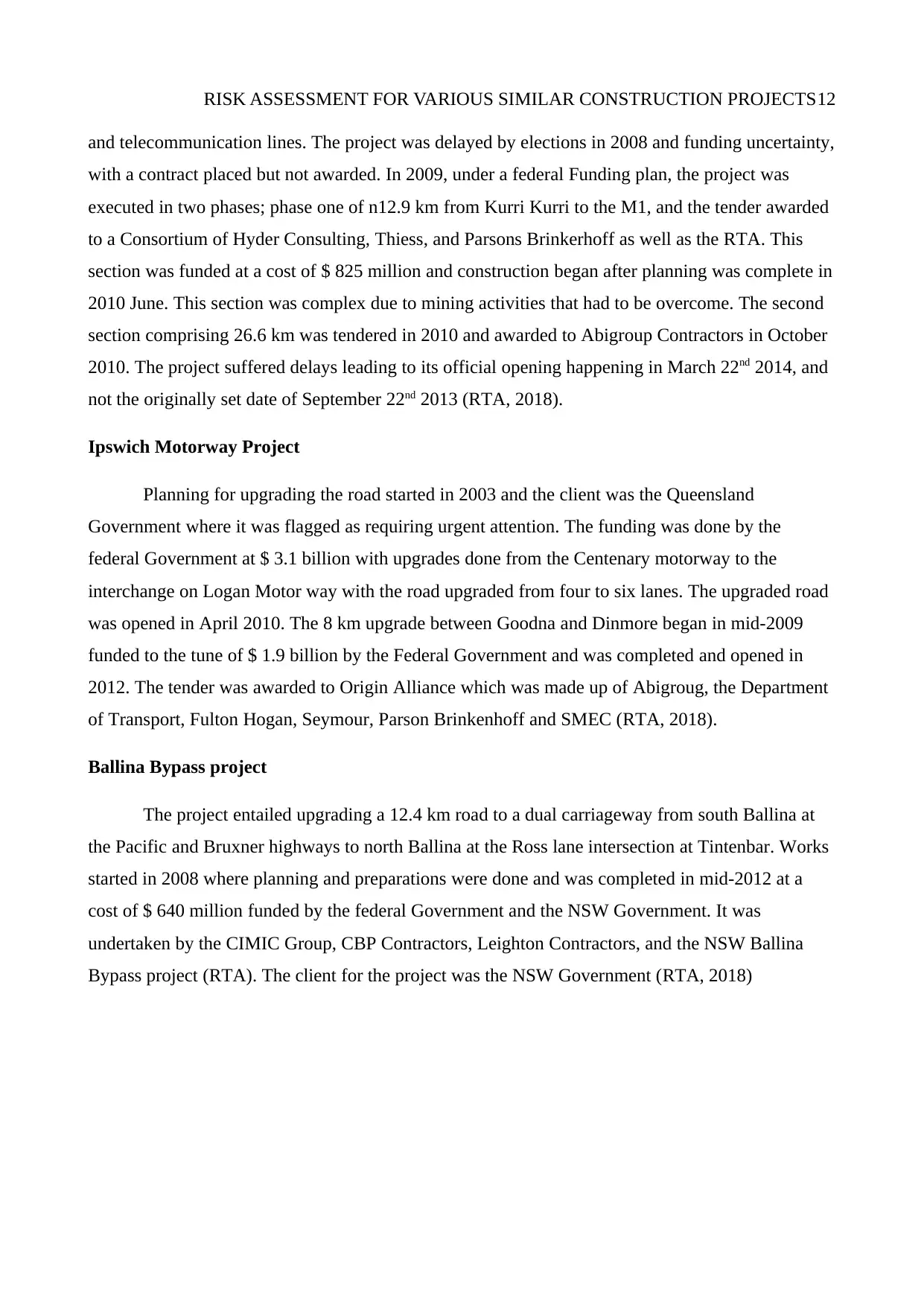
RISK ASSESSMENT FOR VARIOUS SIMILAR CONSTRUCTION PROJECTS12
and telecommunication lines. The project was delayed by elections in 2008 and funding uncertainty,
with a contract placed but not awarded. In 2009, under a federal Funding plan, the project was
executed in two phases; phase one of n12.9 km from Kurri Kurri to the M1, and the tender awarded
to a Consortium of Hyder Consulting, Thiess, and Parsons Brinkerhoff as well as the RTA. This
section was funded at a cost of $ 825 million and construction began after planning was complete in
2010 June. This section was complex due to mining activities that had to be overcome. The second
section comprising 26.6 km was tendered in 2010 and awarded to Abigroup Contractors in October
2010. The project suffered delays leading to its official opening happening in March 22nd 2014, and
not the originally set date of September 22nd 2013 (RTA, 2018).
Ipswich Motorway Project
Planning for upgrading the road started in 2003 and the client was the Queensland
Government where it was flagged as requiring urgent attention. The funding was done by the
federal Government at $ 3.1 billion with upgrades done from the Centenary motorway to the
interchange on Logan Motor way with the road upgraded from four to six lanes. The upgraded road
was opened in April 2010. The 8 km upgrade between Goodna and Dinmore began in mid-2009
funded to the tune of $ 1.9 billion by the Federal Government and was completed and opened in
2012. The tender was awarded to Origin Alliance which was made up of Abigroug, the Department
of Transport, Fulton Hogan, Seymour, Parson Brinkenhoff and SMEC (RTA, 2018).
Ballina Bypass project
The project entailed upgrading a 12.4 km road to a dual carriageway from south Ballina at
the Pacific and Bruxner highways to north Ballina at the Ross lane intersection at Tintenbar. Works
started in 2008 where planning and preparations were done and was completed in mid-2012 at a
cost of $ 640 million funded by the federal Government and the NSW Government. It was
undertaken by the CIMIC Group, CBP Contractors, Leighton Contractors, and the NSW Ballina
Bypass project (RTA). The client for the project was the NSW Government (RTA, 2018)
and telecommunication lines. The project was delayed by elections in 2008 and funding uncertainty,
with a contract placed but not awarded. In 2009, under a federal Funding plan, the project was
executed in two phases; phase one of n12.9 km from Kurri Kurri to the M1, and the tender awarded
to a Consortium of Hyder Consulting, Thiess, and Parsons Brinkerhoff as well as the RTA. This
section was funded at a cost of $ 825 million and construction began after planning was complete in
2010 June. This section was complex due to mining activities that had to be overcome. The second
section comprising 26.6 km was tendered in 2010 and awarded to Abigroup Contractors in October
2010. The project suffered delays leading to its official opening happening in March 22nd 2014, and
not the originally set date of September 22nd 2013 (RTA, 2018).
Ipswich Motorway Project
Planning for upgrading the road started in 2003 and the client was the Queensland
Government where it was flagged as requiring urgent attention. The funding was done by the
federal Government at $ 3.1 billion with upgrades done from the Centenary motorway to the
interchange on Logan Motor way with the road upgraded from four to six lanes. The upgraded road
was opened in April 2010. The 8 km upgrade between Goodna and Dinmore began in mid-2009
funded to the tune of $ 1.9 billion by the Federal Government and was completed and opened in
2012. The tender was awarded to Origin Alliance which was made up of Abigroug, the Department
of Transport, Fulton Hogan, Seymour, Parson Brinkenhoff and SMEC (RTA, 2018).
Ballina Bypass project
The project entailed upgrading a 12.4 km road to a dual carriageway from south Ballina at
the Pacific and Bruxner highways to north Ballina at the Ross lane intersection at Tintenbar. Works
started in 2008 where planning and preparations were done and was completed in mid-2012 at a
cost of $ 640 million funded by the federal Government and the NSW Government. It was
undertaken by the CIMIC Group, CBP Contractors, Leighton Contractors, and the NSW Ballina
Bypass project (RTA). The client for the project was the NSW Government (RTA, 2018)
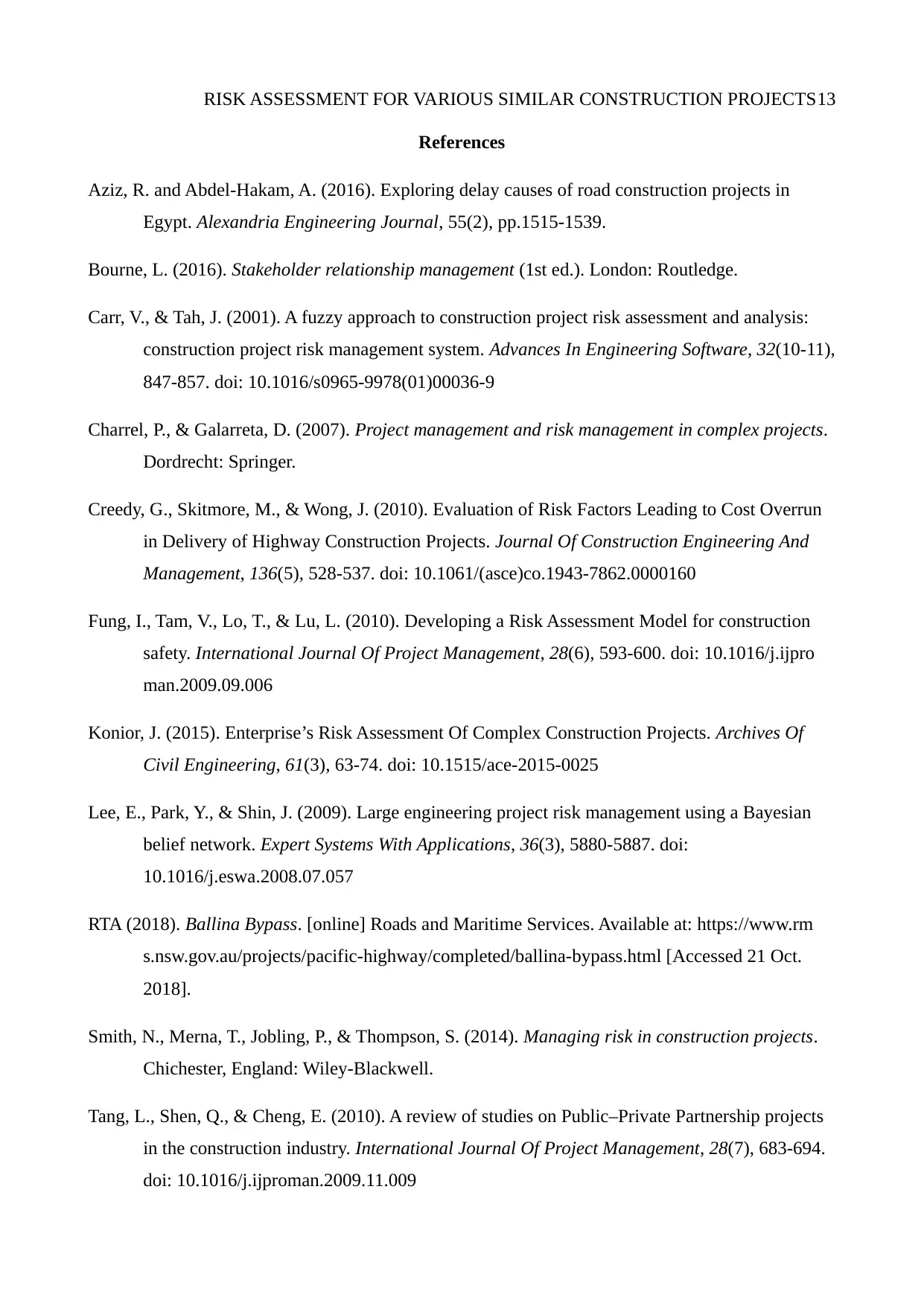
RISK ASSESSMENT FOR VARIOUS SIMILAR CONSTRUCTION PROJECTS13
References
Aziz, R. and Abdel-Hakam, A. (2016). Exploring delay causes of road construction projects in
Egypt. Alexandria Engineering Journal, 55(2), pp.1515-1539.
Bourne, L. (2016). Stakeholder relationship management (1st ed.). London: Routledge.
Carr, V., & Tah, J. (2001). A fuzzy approach to construction project risk assessment and analysis:
construction project risk management system. Advances In Engineering Software, 32(10-11),
847-857. doi: 10.1016/s0965-9978(01)00036-9
Charrel, P., & Galarreta, D. (2007). Project management and risk management in complex projects.
Dordrecht: Springer.
Creedy, G., Skitmore, M., & Wong, J. (2010). Evaluation of Risk Factors Leading to Cost Overrun
in Delivery of Highway Construction Projects. Journal Of Construction Engineering And
Management, 136(5), 528-537. doi: 10.1061/(asce)co.1943-7862.0000160
Fung, I., Tam, V., Lo, T., & Lu, L. (2010). Developing a Risk Assessment Model for construction
safety. International Journal Of Project Management, 28(6), 593-600. doi: 10.1016/j.ijpro
man.2009.09.006
Konior, J. (2015). Enterprise’s Risk Assessment Of Complex Construction Projects. Archives Of
Civil Engineering, 61(3), 63-74. doi: 10.1515/ace-2015-0025
Lee, E., Park, Y., & Shin, J. (2009). Large engineering project risk management using a Bayesian
belief network. Expert Systems With Applications, 36(3), 5880-5887. doi:
10.1016/j.eswa.2008.07.057
RTA (2018). Ballina Bypass. [online] Roads and Maritime Services. Available at: https://www.rm
s.nsw.gov.au/projects/pacific-highway/completed/ballina-bypass.html [Accessed 21 Oct.
2018].
Smith, N., Merna, T., Jobling, P., & Thompson, S. (2014). Managing risk in construction projects.
Chichester, England: Wiley-Blackwell.
Tang, L., Shen, Q., & Cheng, E. (2010). A review of studies on Public–Private Partnership projects
in the construction industry. International Journal Of Project Management, 28(7), 683-694.
doi: 10.1016/j.ijproman.2009.11.009
References
Aziz, R. and Abdel-Hakam, A. (2016). Exploring delay causes of road construction projects in
Egypt. Alexandria Engineering Journal, 55(2), pp.1515-1539.
Bourne, L. (2016). Stakeholder relationship management (1st ed.). London: Routledge.
Carr, V., & Tah, J. (2001). A fuzzy approach to construction project risk assessment and analysis:
construction project risk management system. Advances In Engineering Software, 32(10-11),
847-857. doi: 10.1016/s0965-9978(01)00036-9
Charrel, P., & Galarreta, D. (2007). Project management and risk management in complex projects.
Dordrecht: Springer.
Creedy, G., Skitmore, M., & Wong, J. (2010). Evaluation of Risk Factors Leading to Cost Overrun
in Delivery of Highway Construction Projects. Journal Of Construction Engineering And
Management, 136(5), 528-537. doi: 10.1061/(asce)co.1943-7862.0000160
Fung, I., Tam, V., Lo, T., & Lu, L. (2010). Developing a Risk Assessment Model for construction
safety. International Journal Of Project Management, 28(6), 593-600. doi: 10.1016/j.ijpro
man.2009.09.006
Konior, J. (2015). Enterprise’s Risk Assessment Of Complex Construction Projects. Archives Of
Civil Engineering, 61(3), 63-74. doi: 10.1515/ace-2015-0025
Lee, E., Park, Y., & Shin, J. (2009). Large engineering project risk management using a Bayesian
belief network. Expert Systems With Applications, 36(3), 5880-5887. doi:
10.1016/j.eswa.2008.07.057
RTA (2018). Ballina Bypass. [online] Roads and Maritime Services. Available at: https://www.rm
s.nsw.gov.au/projects/pacific-highway/completed/ballina-bypass.html [Accessed 21 Oct.
2018].
Smith, N., Merna, T., Jobling, P., & Thompson, S. (2014). Managing risk in construction projects.
Chichester, England: Wiley-Blackwell.
Tang, L., Shen, Q., & Cheng, E. (2010). A review of studies on Public–Private Partnership projects
in the construction industry. International Journal Of Project Management, 28(7), 683-694.
doi: 10.1016/j.ijproman.2009.11.009
Paraphrase This Document
Need a fresh take? Get an instant paraphrase of this document with our AI Paraphraser
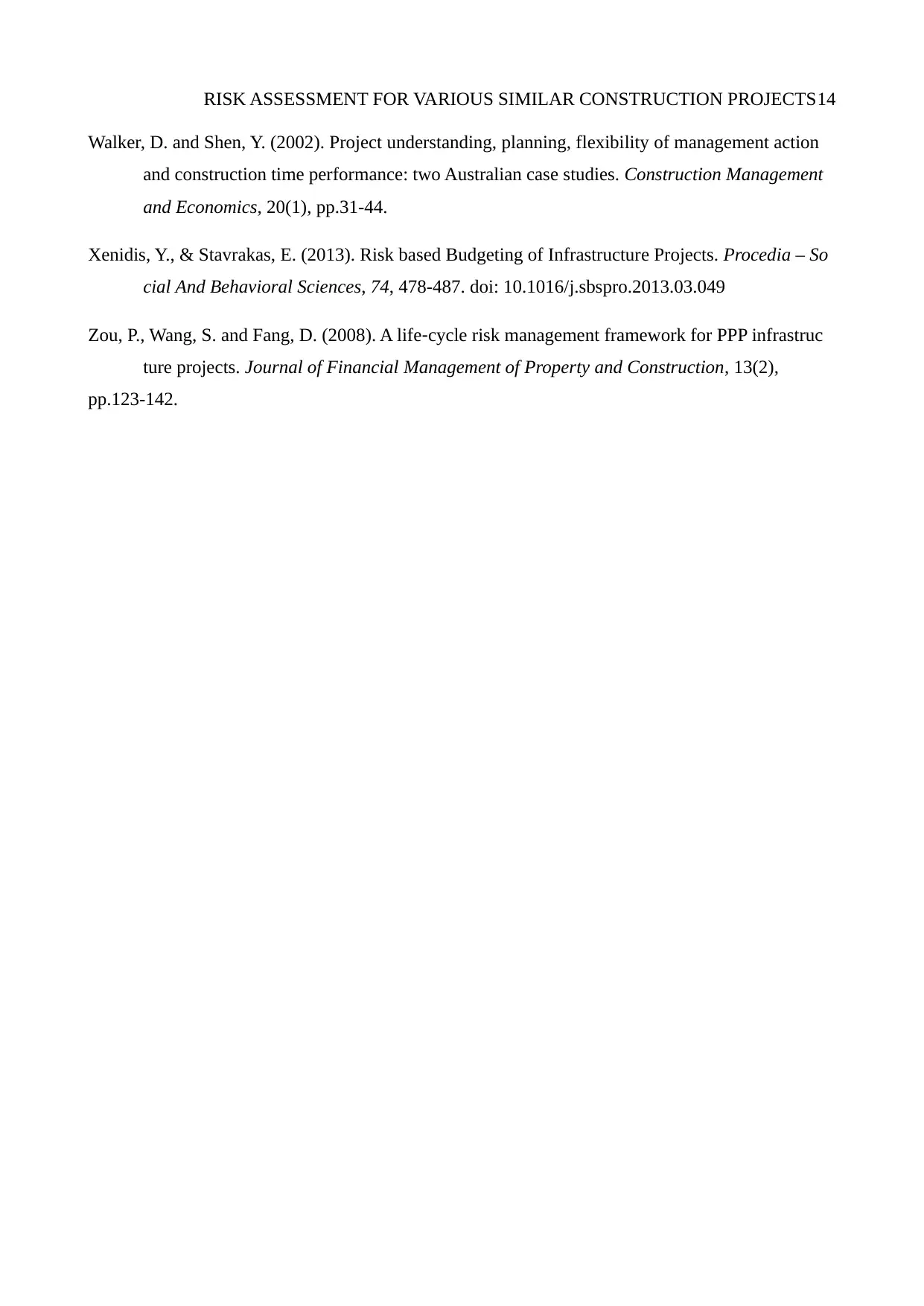
RISK ASSESSMENT FOR VARIOUS SIMILAR CONSTRUCTION PROJECTS14
Walker, D. and Shen, Y. (2002). Project understanding, planning, flexibility of management action
and construction time performance: two Australian case studies. Construction Management
and Economics, 20(1), pp.31-44.
Xenidis, Y., & Stavrakas, E. (2013). Risk based Budgeting of Infrastructure Projects. Procedia – So
cial And Behavioral Sciences, 74, 478-487. doi: 10.1016/j.sbspro.2013.03.049
Zou, P., Wang, S. and Fang, D. (2008). A life‐cycle risk management framework for PPP infrastruc
ture projects. Journal of Financial Management of Property and Construction, 13(2),
pp.123-142.
Walker, D. and Shen, Y. (2002). Project understanding, planning, flexibility of management action
and construction time performance: two Australian case studies. Construction Management
and Economics, 20(1), pp.31-44.
Xenidis, Y., & Stavrakas, E. (2013). Risk based Budgeting of Infrastructure Projects. Procedia – So
cial And Behavioral Sciences, 74, 478-487. doi: 10.1016/j.sbspro.2013.03.049
Zou, P., Wang, S. and Fang, D. (2008). A life‐cycle risk management framework for PPP infrastruc
ture projects. Journal of Financial Management of Property and Construction, 13(2),
pp.123-142.
1 out of 14
Your All-in-One AI-Powered Toolkit for Academic Success.
+13062052269
info@desklib.com
Available 24*7 on WhatsApp / Email
![[object Object]](/_next/static/media/star-bottom.7253800d.svg)
Unlock your academic potential
© 2024 | Zucol Services PVT LTD | All rights reserved.


